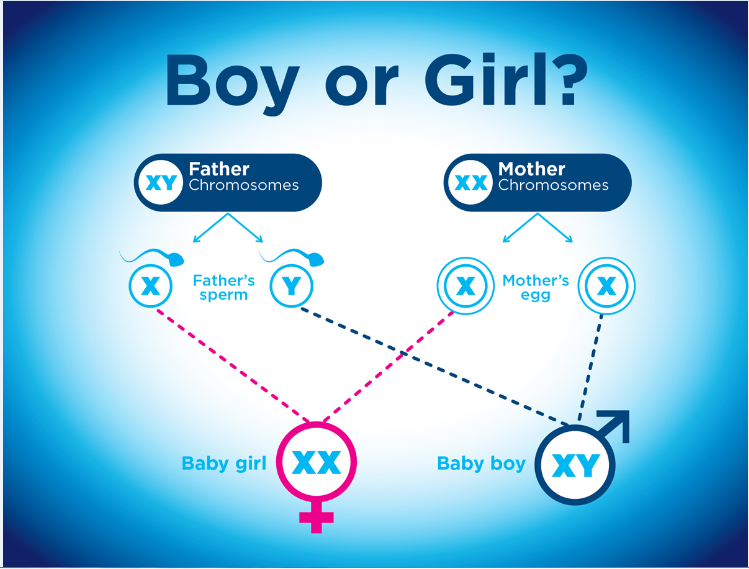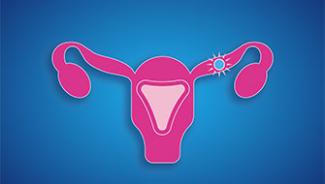
What makes your baby a boy or a girl?
Whether your baby is a boy or a girl is determined by the chromosome it inherits from its father. The egg from its mother always contains an X (female) chromosome, but the sperm contains either a female or a Y (male) chromosome. When the egg is fertilised the chromosomes come together and if they are XY a baby boy is conceived and if they are XX a baby girl is conceived.

Can you choose to have boy or a girl?
When we look at the statistics the chances of having a boy or a girl are almost the same and there’s no medical evidence to suggest we can influence this.
You may, however, have heard about the ‘Shettles Method’. In the 1970s Dr Shettles found that female and male sperm had different characteristics. He believed that identifying these differences may help couples to try to conceive a boy or a girl.1
When to have sex
It’s all about a race to the egg…
Shettles found male sperm to be smaller, would swim faster and have a shorter life span than the female sperm. He believed that if a couple had sex around the time of ovulation the male sperm would be more likely to reach the egg before the female sperm. If the egg fertilised the couple were more likely to conceive a baby boy. Female sperm were found to be slower, fitter and would live longer than male sperm so making love earlier in the fertile window meant they would still be alive to fertilise the egg, and more likely to conceive a baby girl.
Whilst it’s a fascinating theory, studies since then have shown that the timing of sex in relation to ovulation doesn’t actually influence whether you conceive a boy or a girl.2
Whether you are interested in conceiving a boy or a girl, it’s still important to remember that there are only a few days in every cycle when you can get pregnant. Using Clearblue Digital Ovulation Tests identifies your 2 most fertile days so you can be confident you are trying at the right time.
Whether you are interested in conceiving a boy or a girl, it’s still important to remember that there are only a few days in every cycle when you can get pregnant. Using Clearblue Advanced Ovulation Test typically identifies 4 or more fertile days giving you more opportunities to get pregnant.3
Sexual positions
Shettles also suggested that the sexual position at the time of the father’s orgasm may help the chances of conceiving a boy or girl. Deep penetration, for example doggy style, means the male sperm that can swim faster start their race closer to the cervix and are more likely to reach the egg first, resulting in a boy. To try and conceive a girl, Shettles suggested avoiding deep penetration, favouring the missionary position.
It’s another interesting theory, but again there’s nothing to support this idea. Dr Michael Thomas MD (fertility specialist) actually advises that there are no methods to affect the sex of your child, including sexual position.
Eating certain foods
Cervical mucus is most sperm-friendly at the time of ovulation, when it is more alkaline. Prior to ovulation the mucus is more acidic which is not ideal for sperm and only the fittest can survive. Shettles suggested that making the vagina more acidic means the fitter female sperm are more likely to survive and a baby girl is conceived. A more alkaline environment is better for the faster male sperm and a baby boy is conceived. You could try different foods to influence your vaginal pH, but we haven’t been able to find any evidence that this works.
Can I get pregnant with twins?
Twins happen when more than one baby develops in the womb. There are 2 types of twins: non-identical (when more than one egg is fertilised) and identical (when one single fertilised egg splits in early pregnancy).
Twins have become more common over the past 20 years – largely due to the use of fertility treatments.

There is no way you can choose to have twins, but some factors can make it more likely to happen:
- Assisted reproduction technology (ART) – such as in vitro fertilisation (IVF), where eggs are fertilised outside the body. A number of embryos might be produced and the couple may have the opportunity to have one or more transferred back into the womb. If they choose two or more to be transferred, there is a chance that more than one of these embryos will implant and the couple will have more than one baby
- Medicines - women who take ovulation inducing drugs (e.g. clomiphene citrate) which stimulate the ovaries to produce eggs, have a higher chance of having a twins or a multiple pregnancy4
- Age – women over the age of 35 have a higher chance of having twins. This is because older women produce more follicle stimulating hormone (FSH) as they age, which can cause more than one egg to be released during ovulation4
- Heredity – if a woman is a twin, or has twins in her family, then she has an increased chance of having twins herself. This is due to an inherited tendency to release more than one egg during ovulation5
- Shettle LB. Intl Journal of Gyn & Obs (1970): 643-647.
- Wilcox A J et al. New Eng J of Med (1995): 1517-1521.
- In a study of 87 women, 4 or more fertile days were identified in 80% of cycles (2012).
- www.acog.org/-/media/Womens-Health/Multiples-When-Its-Twins-Triplets-or-More.pdf
- Hoeskstra C et al. Hum Repro Update (2008): 14; 37-47

What is ovulation?
Understand more about ovulation: what it is, when it happens, its signs, how to track it…


